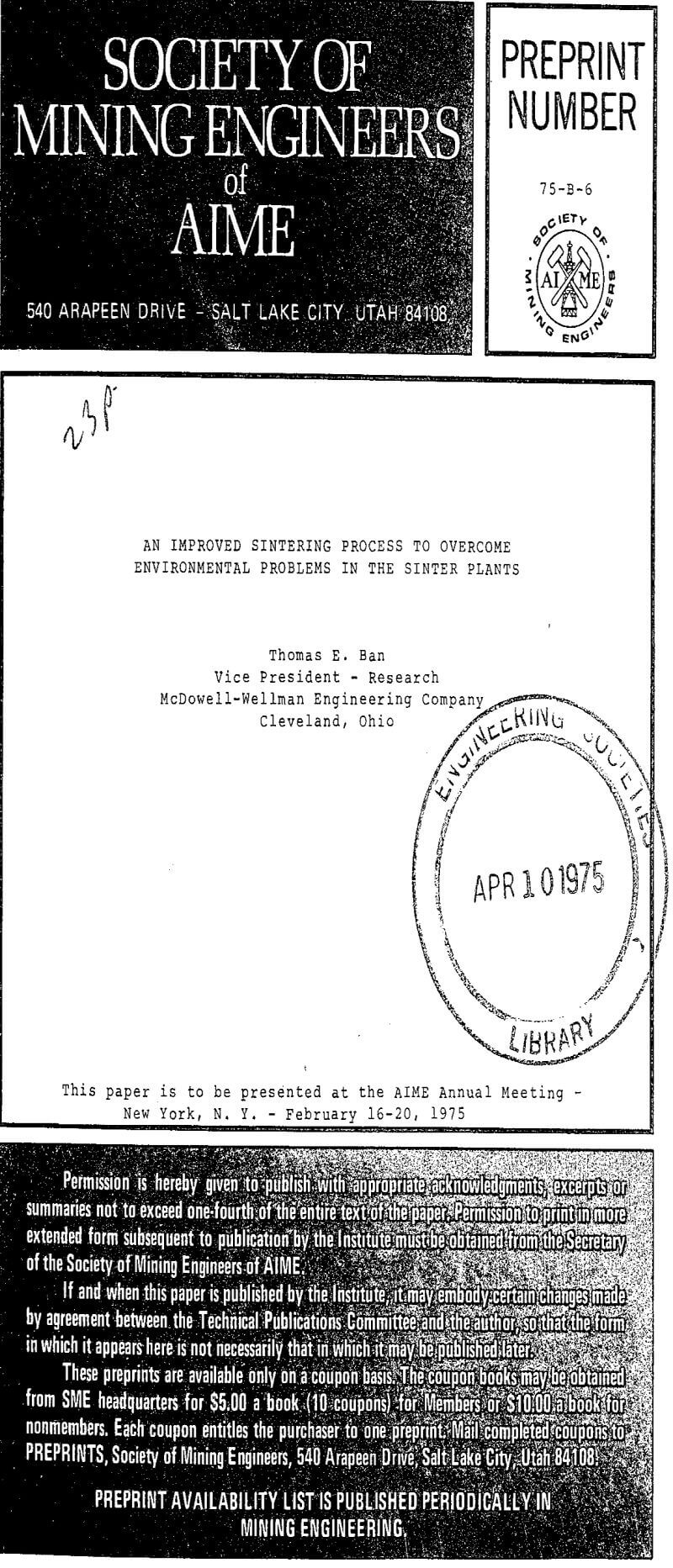Table of Contents
The continuous sintering process was invented more than 60 years ago by two metallurgists, Arthur S. Dwight and Richard L. Lloyd, who saw a need for automation in mineral processing. Their specific objective was to beneficiate copper ore by desulfurizing and agglomerating it for copper blast furnace smelting at the Cananea plant in Mexico. Since their early development the process expanded widely in scope, size, and application. The current worldwide sintering applications exceed 250 million tons per year for agglomerating ores of lead, manganese, zinc, and iron. Sintering is also widely used for production of sintered lightweight aggregate from clays, shales, and fly ash.
Description of Sintering Process
An improved sintering process which offers considerable advantages over conventional sintering has been developed at the Dwight-Lloyd Research Laboratories of the McDowell-Wellman Engineering Company, The new process overcomes some of the salient air pollution problems and provides a high quality product at lower capital and operating costs. The techniques can embody the Dwight-Lloyd liquid sealed circular machine using a recycle draft and in situ cooling, the combinations of which lead to very practical and economic benefits.
A simplified diagram of the conventional sintering process is shown and illustrate the sequence of sintering, hot crushing, hot screening, and cooling. The relatively large exhaust draft requirements are illustrated by the comparative sizes of the fan, dust collector (box), and stack. Two boxes are shown on the sinter draft system to denote a series of draft treatment such as absorption or incineration for removal of combustibles followed by dust precipitation. Total draft exhausted from such a sintering process is very high in volume and amounts to an exhaust draft to sinter product weight ratio of about 7.6 to 12.
Features of Conventional Sintering
The hot crushing-screening-recycling operations of conventional practices are recognized as one of the highest maintenance and lowest attended areas of the sinter plant. The hot dusty environment contributes to excessive machinery wear and inadequate conditions for proper attention. Sinter cake as discharged from the sintering machine ranges from cold brittle surface portions to hot plastic semifused portions. On numerous occasions the cake contains unreacted dry and wet portions of the burden which further contribute to maintenance and operating problems on the discharge end.
The normal forced or induced air draft convection cooling of hot sinter presents specific problems inherent with gas-solid segregation brought about by treatment of solid materials with a wide range of particle sizes. Invariably granular solids segregate through movement by piling, charging, and transferring wherein larger sized particles orient in locations remote from fines. Crushed and screened cooler charge generally ranges from about six-inch pieces to residual granular and unaffected micron sized particles which when bedded on a cooler tend to segregate and cause paths for preferential cooling draft flow.
Exhaust draft streams of conventional sinter plant systems are generally qualified as follows:
- Sinter Exhaust
- Discharge End Exhaust
- Cooler Exhaust
- Cooler Discharge Exhaust
The removal of pollutants such as fine liquid and solid particulates and hydrocarbon gases requires large equipment which has high capital and operating costs. High efficiency removal of solid particulates can be accomplished with dry electrostatic precipitation which can arrest dry materials for recycle or disposal without attendant water pollution problems from soluble particulates.
Technology of the Improved Sintering Process
The warm humid draft from the initial windboxes of sintering is approximately 250 °F and contains about 9 percent moisture and 15 percent oxygen draft. Composition varies somewhat from case to case depending upon the amounts of carbonates and hydrates decomposed during sintering. Continuous sintering test data has shown that such recycle draft for the terminal sintering zones does not interfere with sintering practices and has been found in some instances to be beneficial. The capability of sintering with relatively low percentages of oxygen has been well-known because high excess gas rates are normally applied for purposes of heat transfer rather than oxidation. This factor favors utilization of humid drafts. Relatively high percentages of moisture in sinter drafts are generally disfavored because of possibilities of condensing in lower sinter layers and interfering with sinter bed permeability. This has not been found to be a problem when the draft is recycled to the terminal ends of sintering which have relatively dry beds in the lower layers beneath the fire line. The attainment of minimum exhaust draft flow, increased exhaust temperature, and increased exhaust humidity has been fulfilled in continuous sintering tests which enables production of exhaust of approximately 450 °F with a moisture content generally more than 15 percent, ideal conditions for dry electrostatic precipitation.



